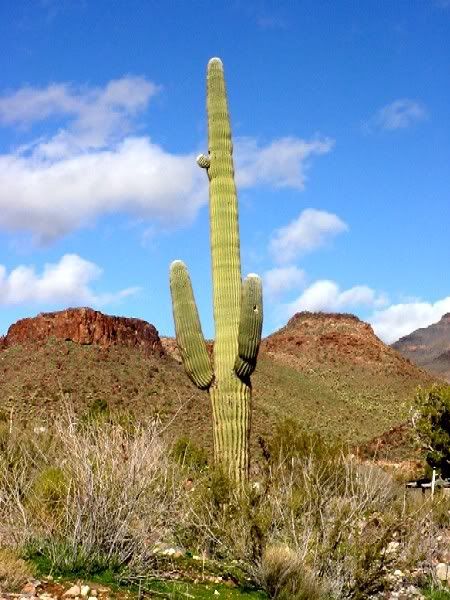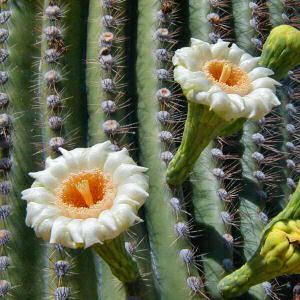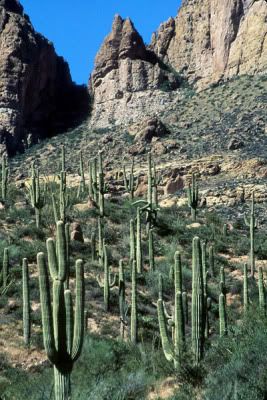The Saguaro (Carnegiea gigantea) is the largest cactus in the  USA, commonly reaching a height of 12 metres and an age of up to 200 years. It is one of the most characteristic plants of the Sonoran Desert, but actually has a quite limited geographical range, centred on southern Arizona and extending into western Sonora (Mexico). The saguaro is the state flower of Arizona. The skin is smooth and waxy, the trunk and stems have stout, 2-inch spines clustered on their ribs. When water is absorbed , the outer pulp of the Saguaro can expand like an accordion, increasing the diameter of the stem and, in this way, can increase its weight by up to a ton. The Saguaro grows very slowly -- perhaps an inch a year -- but to a great height, 15 to 50 feet. The largest plants, with more than 5 arms, are estimated to be 200 years old. An average old Saguaro would have 5 arms and be about 30 feet tall.
USA, commonly reaching a height of 12 metres and an age of up to 200 years. It is one of the most characteristic plants of the Sonoran Desert, but actually has a quite limited geographical range, centred on southern Arizona and extending into western Sonora (Mexico). The saguaro is the state flower of Arizona. The skin is smooth and waxy, the trunk and stems have stout, 2-inch spines clustered on their ribs. When water is absorbed , the outer pulp of the Saguaro can expand like an accordion, increasing the diameter of the stem and, in this way, can increase its weight by up to a ton. The Saguaro grows very slowly -- perhaps an inch a year -- but to a great height, 15 to 50 feet. The largest plants, with more than 5 arms, are estimated to be 200 years old. An average old Saguaro would have 5 arms and be about 30 feet tall.
 USA, commonly reaching a height of 12 metres and an age of up to 200 years. It is one of the most characteristic plants of the Sonoran Desert, but actually has a quite limited geographical range, centred on southern Arizona and extending into western Sonora (Mexico). The saguaro is the state flower of Arizona. The skin is smooth and waxy, the trunk and stems have stout, 2-inch spines clustered on their ribs. When water is absorbed , the outer pulp of the Saguaro can expand like an accordion, increasing the diameter of the stem and, in this way, can increase its weight by up to a ton. The Saguaro grows very slowly -- perhaps an inch a year -- but to a great height, 15 to 50 feet. The largest plants, with more than 5 arms, are estimated to be 200 years old. An average old Saguaro would have 5 arms and be about 30 feet tall.
USA, commonly reaching a height of 12 metres and an age of up to 200 years. It is one of the most characteristic plants of the Sonoran Desert, but actually has a quite limited geographical range, centred on southern Arizona and extending into western Sonora (Mexico). The saguaro is the state flower of Arizona. The skin is smooth and waxy, the trunk and stems have stout, 2-inch spines clustered on their ribs. When water is absorbed , the outer pulp of the Saguaro can expand like an accordion, increasing the diameter of the stem and, in this way, can increase its weight by up to a ton. The Saguaro grows very slowly -- perhaps an inch a year -- but to a great height, 15 to 50 feet. The largest plants, with more than 5 arms, are estimated to be 200 years old. An average old Saguaro would have 5 arms and be about 30 feet tall.The Saguaro has a surprisingly shallow root system , considering its great height and weight. It is supported by a tap root that is only a pad about 3 feet long, as well as numerous stout roots no deeper than a foot. More smaller roots run radially to a distance equal to the height of the Saguaro. These roots wrap about rocks providing adequate anchorage from winds across the rocky bajadas.
Flowering
 The slow growth and great capacity of the Saguaro to store water allow it to flower every year, regardless of rainfall. The night-blooming flowers, about 3 inches wide, have many creamy-white petals around a tube about 4 inches long. Like most cactus, the buds appear on the southeastern exposure of stem tips, and flowers may completely encircle stems in a good year. For many years it has been assumed that bats are the major pollinators of saguaros, because the flowers have all the features characteristic of bat pollination - nocturnal opening of the buds (although they remain open through to midday), heavy scent, copious nectar, etc. However, studies in which individual flowers were caged to exclude different types of pollinators in either night or daytime suggest that bees may be the more important pollinators.
The slow growth and great capacity of the Saguaro to store water allow it to flower every year, regardless of rainfall. The night-blooming flowers, about 3 inches wide, have many creamy-white petals around a tube about 4 inches long. Like most cactus, the buds appear on the southeastern exposure of stem tips, and flowers may completely encircle stems in a good year. For many years it has been assumed that bats are the major pollinators of saguaros, because the flowers have all the features characteristic of bat pollination - nocturnal opening of the buds (although they remain open through to midday), heavy scent, copious nectar, etc. However, studies in which individual flowers were caged to exclude different types of pollinators in either night or daytime suggest that bees may be the more important pollinators. 
The 3-inch, oval, green fruit ripens just before the fall rainy season, splitting open to reveal the bright-red, pulpy flesh which all desert creatures seem to relish. This fruit was an especially important food source to Native Americans of the region who used the flesh, seeds and juice. Seeds from the Saguaro fruit are prolific -- as many as 4,000 to a single fruit -- probably the largest number per flower of any desert cactus.
No comments:
Post a Comment